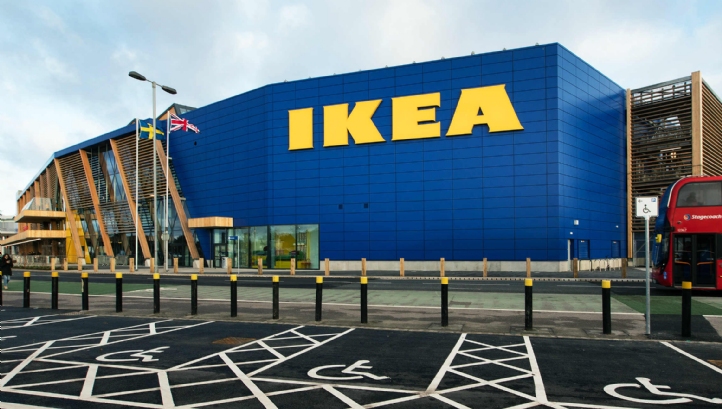edie reporter Sarah George takes a trip to Greenwich to learn how Ikea’s new store – touted as its “most sustainable” UK location to date – evidences the company’s shift towards circularity and ‘climate-positivity’.
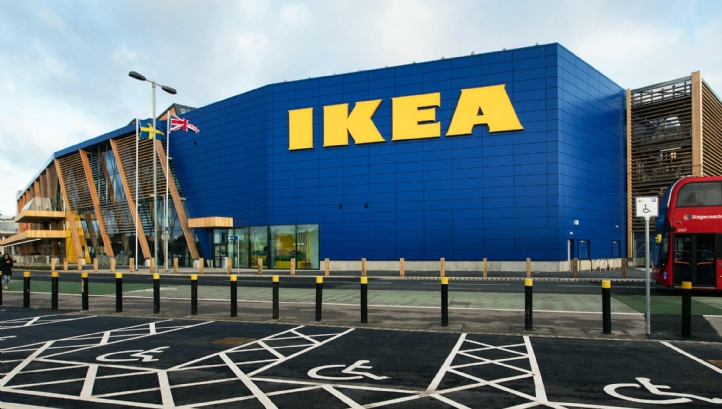
Ikea UK claims that the store, which it hopes will gain BREEAM ‘Excellent’ accreditation, is its most sustainable to date
When you think of Ikea, visions of large, box-shaped blue buildings on the outskirts of towns and cities probably spring to mind. With this distinctive retail model comes several environmental and social challenges, from customer reliance on personal cars, to the struggle of transporting purchases across urban environments which are becoming ever-more densely populated.
Considered by many to be a leader in the corporate sustainability sphere, Ikea has, unsurprisingly, attempted to alleviate certain societal and environmental challenges through its sweeping array of 2030 ‘People and Planet Positive‘ sustainability goals. From re-designing all products for recyclability and reuse to generating more renewable power than it uses, major parts of the strategy focus on healthy and sustainable living for consumers and circular and climate action for the planet.
The fact that the new Greenwich Peninsula store is meant to embody the firm’s ambitious goals meant I wasn’t quite sure what to expect when I made the trip to the borough’s Millennium Way Retail Park.
The media invitation to the store offers promises of rooftop yoga and upcycling workshops. It has also been requested that I leave my car at home for the journey. After a 10-minute walk from the nearest station, I’m finally greeted by that iconic blue facade, still alive and well in this “most sustainable” UK store. However, it is evident at first glance that I’m entering a building that not only showcases Ikea’s commitment to sustainability, but captures the immense sense of the belief that Ikea has in its CSR focus.
While it’s still blue, the exterior looks worlds away from my local Ikea in Croydon. The building is rounded in shape and has an entire wall made up of double-glazed glass, which makes it instantly lighter and airier. The fact that I can see the rooftop solar panels and wooden beams from the car park gives the store suggests that Ikea wants consumers to be aware of its environmental prowess.
The building is designed to represent a “huge shift” in the way the brand makes sustainability tangible to its staff and customers. That is what I am told by Ikea UK and Ireland’s country sustainability manager Hege Sæbjørnsen, who is showing a select group of media representatives around the 32,000sqm store ahead of its official opening on 7 February – an event I later find out attracted queues of more than 600 shoppers.
Accompanied by the store’s manager, Helen Aylett, Sæbjørnsen runs through some of the store’s key ‘built-in’ features, which include a 2,600-panel rooftop solar array, ground-source heating systems, rainwater harvesting facilities and energy-efficient lighting.
Compounded by a number of other technologies and design points, these features have enabled the building to achieve BREEAM ‘Excellent’ status, with Ikea now aiming for ‘Outstanding’ in the near future – but Sæbjørnsen is keen to emphasise the social sustainability aspects of the store as well.
“Ikea Greenwich is not about someone coming in and having a purely transactional experience, it’s about asking how we can learn from each other and create a hub that people can make their own and use to spur wider action,” she explains as we wait in the store’s 450-seat restaurant.
“We were keen not to go into Greenwich as a big corporate with all the answers, but to take our process of informing ourselves and shaping the store for the community seriously.”
During the four-year process of bringing the store to life, we are told by Sæbjørnsen, everything has been “planned with the community in mind” and with the aim of helping spur the uptake of more sustainable lifestyle choices by customers. Indeed, the global Ikea group has already trebled the sales from its ‘sustainable life at home’ products in recent years and now has its sights set on changing the daily habits of one billion people – notably through the award-winning Live Lagom programme.
We are shown evidence in the form of photos, depicting the store’s community spaces like its solar-powered roof terrace and outdoor wildlife park. But I am keen to see these for myself and learn first-hand how a retailer operating in a sector which has relied on linear economy principles to drive global growth can re-design its business model to meet ever-changing customer demands and pressing environmental challenges.
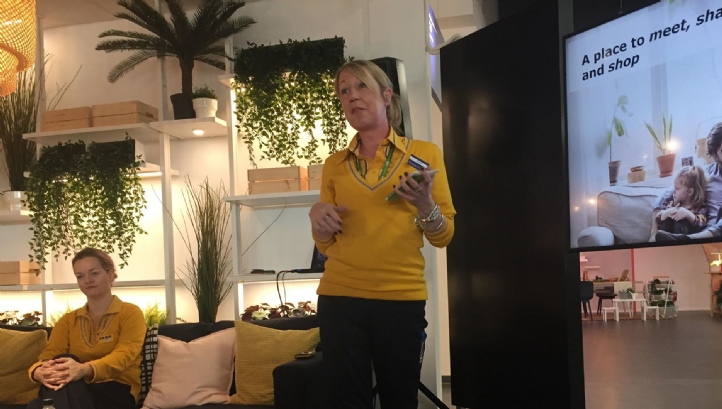
Sustainability in the spotlight
Thankfully, my itchy feet are cured swiftly, as Aylett and Sæbjørnsen offer to split us into groups for a tour of the store, starting with its “core” furniture showrooms.
Perhaps the most striking thing about these rooms is the use of space and lighting, with a window-wall providing passive natural daylighting and products arranged far more sparsely than in any other Ikea.
As we continue deeper into the showrooms, we find that messages encouraging shoppers to leave their cars at home and to return their old furniture for recycling have been printed on walls which would usually be used to sell more product lines. Products made from 100% recycled materials are often given large chunks of wall space and illuminated by spotlights.
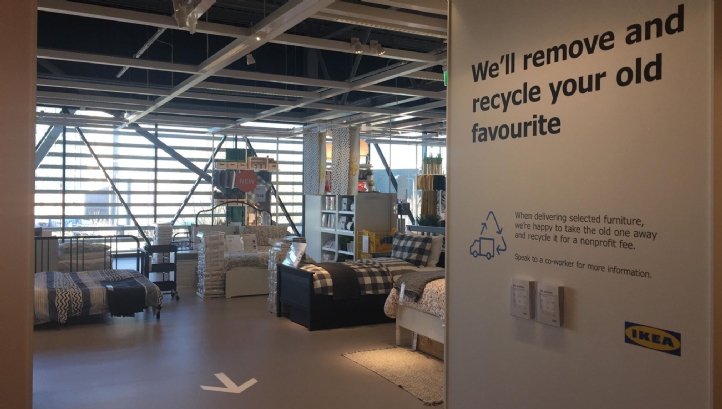
“We found that customers are increasingly keen to not have to look around – and therefore feel like they need to buy something from – every department, or to have a purely transactional experience,” Aylett explains, pointing out “prime sales spaces” which have instead been filled with plants, customer seating or sustainability marketing.
But supporting customers as they move to green their transport habits and stop “taking, making and disposing of” products have taken more than marketing, Sæbjørnsen adds – it has required Ikea to “lay the foundations for big behaviour change”.
For transport, this “foundation-laying” exercise has seen Ikea partner with e-bike courier Zedify to offer discounted, zero-emissions deliveries within a 1.5-mile radius of the store and van rental firm Hertz to bring electric vehicle (EV) rental services to consumers. From a consumer perspective, it has also entailed the installation of 20 EV charging points and installed technologies which display bus and train times, while staff have been asked to pledge to leave their cars at home for their commute.
As for the circular economy – which is one of my favourite sustainability topics to cover – I was glad to hear that Ikea has invested in an extended take-back scheme for Greenwich customers, who will be offered the chance to send furniture free-of-charge for recycling or refurbishment when they book a home delivery. I was also keen to see a new kind of ‘bargain corner’, where goods which are damaged in transit or returned by customers are repaired in-store and offered at a discounted price.
One showroom even depicts the apartment of a couple who make their living selling upcycled goods, and features several old Ikea chairs which have been re-fashioned – a feature I believe serves to put servitisation in the spotlight.
“In the past, we’d never have dreamed of showing products which have been altered like this, let alone dedicating a room to them,” Aylett tells me. “However, the circular economy will be key to our ability to thrive as a business over the next 75 years, and we know that customers are finding it fashionable to be involved with.”
As we continue the tour, we are shown other rooms that showcase low-carbon, resource-efficient lifestyles as an aspirational goal for shoppers, including a family kitchen with a hydroponic farm and an apartment with a “living” wall of plants. Each of these rooms is based on a real London resident and their property.
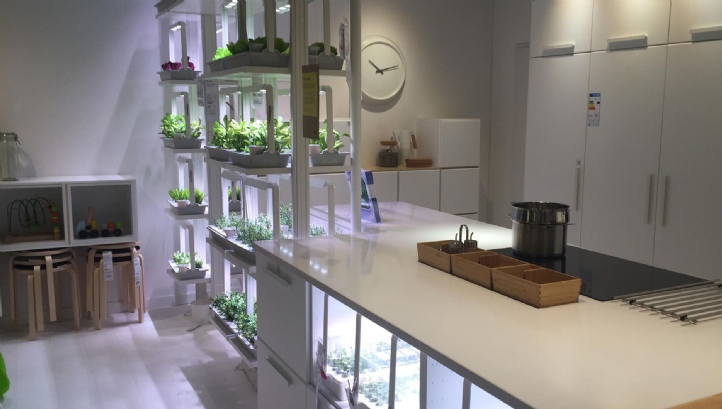
Solar and circular
Later on, we are shown two of the store’s unique features – its roof terrace and ground-floor “Learning Lab”.
Designed as a community space, the roof terrace is almost completely passively lit and features screens showing visitors information about the store’s solar generation in real-time. The solar array covers 70% of the store’s roof and can generate 850kW during peak daylight hours.
I am told that it will meet 50-80% of the store’s energy demands at any one time before being guided down to the ground floor ‘pick and pack’ area, where the sustainability messaging and community-focused, sparse layout from upstairs continues.
In the middle of this department is an unimposing, 75 metre-square room containing a number of workbenches and a projector. This is the Learning Lab – a space which will be used to host consumer-facing workshops on furniture repair, assembly, dis-assembly and upcycling.
“The Learning Lab seems quite humble, but it will be a place of collaboration and co-working for the circular economy,” Sæbjørnsen explains.
“Home furnishing expertise is what we do, so we have to now ask how we can pass on that knowledge and cater for small-home living sustainably as cities like London expand.”
Inside the Learning Lab, volunteers are busy weaving upholstery for bar stools using recycled materials and making insect houses for customer gardens. Sessions like this will be run regularly, Aylett tells us, with some set to be streamed online in order to reach a wider audience. More in-depth courses on more specific focus areas, however, could be monetised and offered to a select group of people, she adds.
“With city living, we are finding that repair skills and other practical learnings are increasingly being lost, even though people are keener to extend the life of their products,” she explains.
“We, therefore, want our customers to benefit from what we have learned and to give us ideas of how we can do better going forward.”
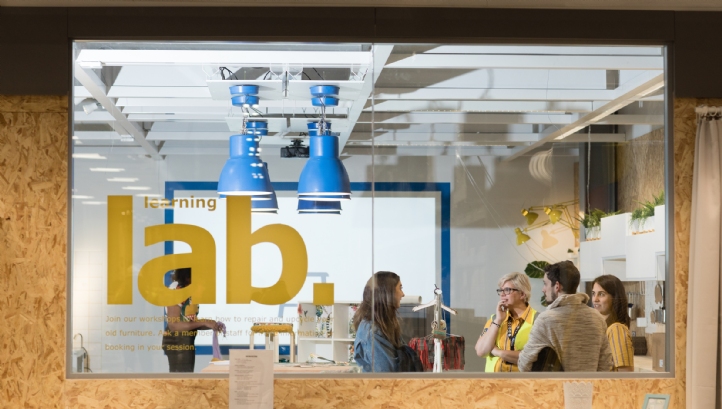
As I prepare to head back home after the tiring but inspiring tour, I am overcome with a desire to buy a whole new set of furniture – a set that will likely benefit from an extended first life and even a second life many years down the line.
But this desire goes beyond a ‘want’ for Ikea’s products, it’s also an appreciation and understanding of the services the retailer is introducing. The store format goes beyond traditional product retail and into servitisation, providing support for extending item lifespans rather than encouraging shoppers to consume past the point of necessity. While such business model shifts are beginning to emerge, particularly in the automotive and fashion sectors, Ikea proves with its Greenwich store that they can be scaled-up and may, in time, better suit consumer demands as well as planetary boundaries.
Whether equal ambition will now become evident across the home improvement sector and within its customer base, is the next frontier. Given Ikea’s scale and influence in this sphere, I’ve got my fingers crossed.
Sarah George

